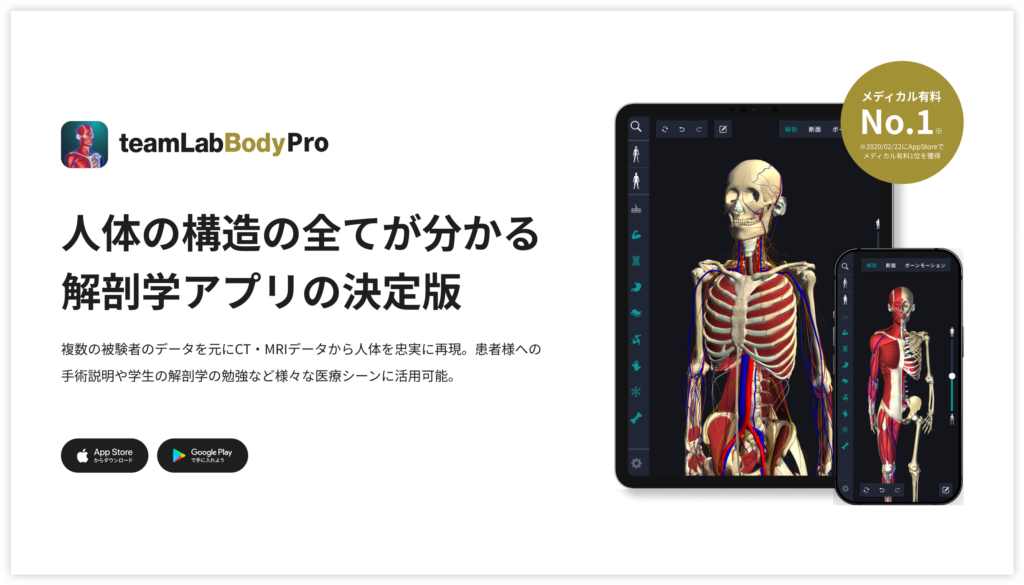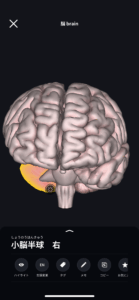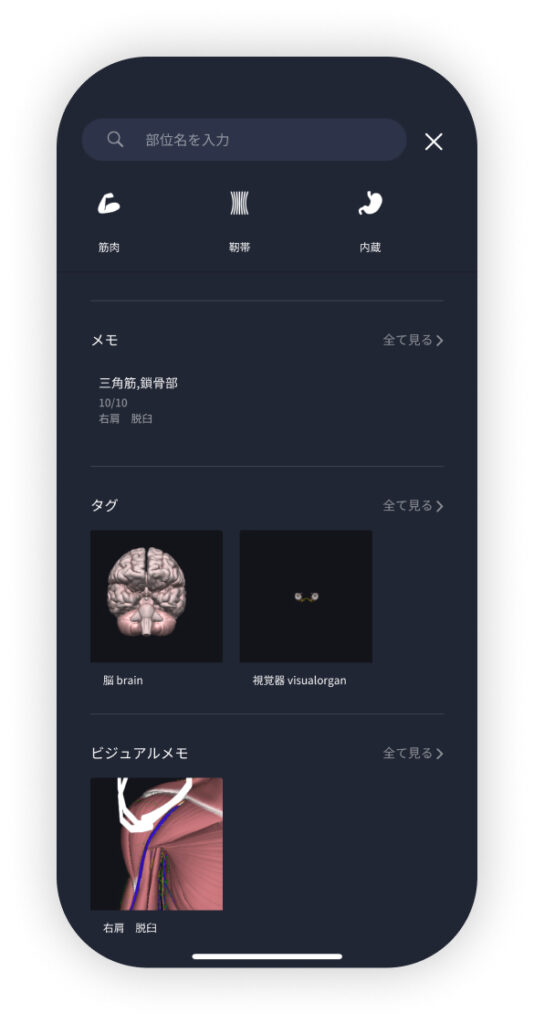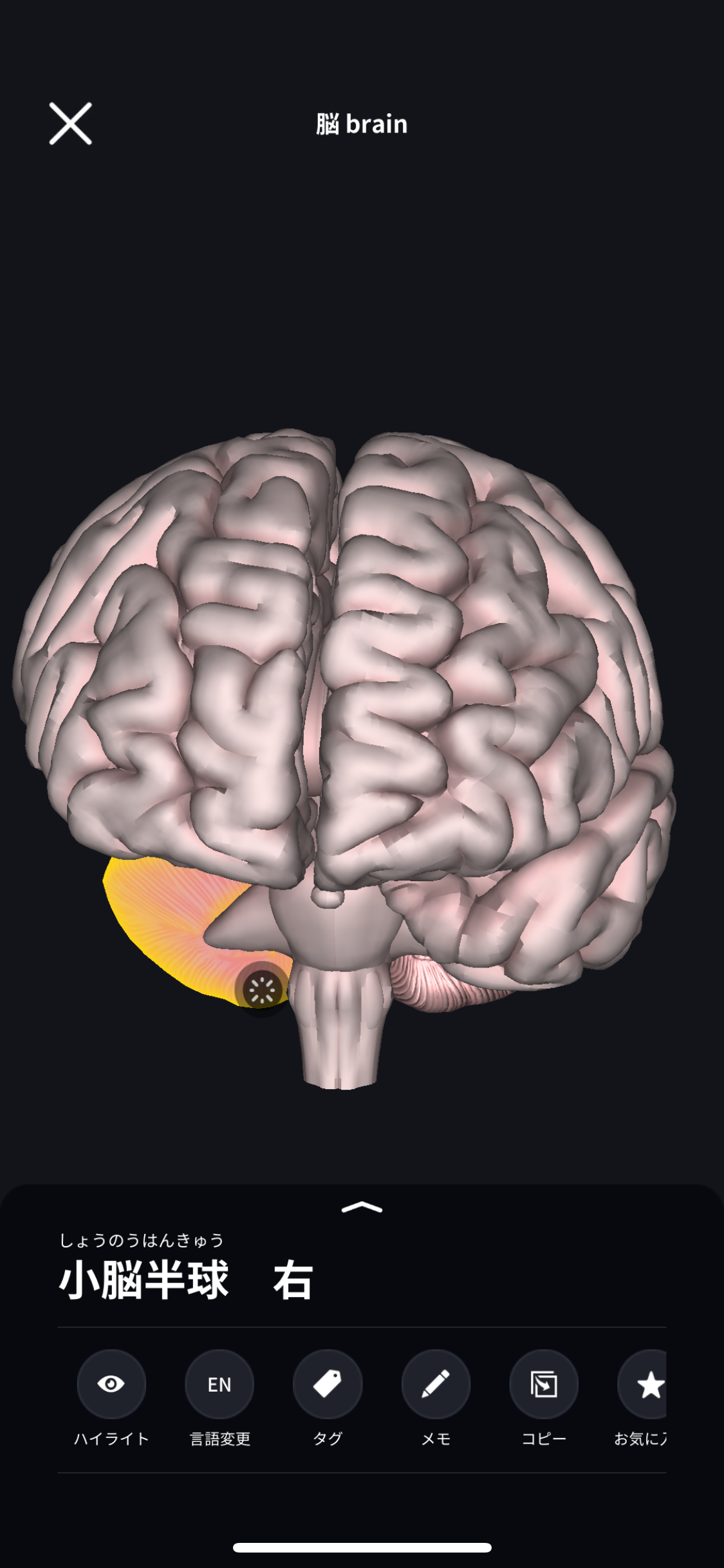beginning
In this article, I will explain effective study methods, starting with knowledge of specialized parts in human anatomy.
In human anatomy, it is necessary not only to memorize the names of various organs, muscles, and bones, but also to remember where they are located in the body. Therefore, it is necessary to learn as efficiently as possible.
I hope you can read this article and use the app to deepen your understanding even a little bit.
Now, I will explain the contents of the “cerebellar hemisphere” and how to study human anatomy.
teamLab Body Pro Free Download
A 3D anatomy app that shows all the structures of the human body
Download teamLab Body Pro here!

What are cerebellar hemispheres?
In the anatomy application, you can view a selection of anatomy 3D models. In this model, there are various observation methods such as surfaces, cross-sections, and nervous systems. This time, I'll explain using an anatomy application.
About the cerebellar hemisphere

Study points
Location and structure of the cerebellar hemispheres
The cerebellar hemisphere is located in the lower posterior part of the vertebrate brain, slightly below the back of the cerebrum. It is located behind the brain stem and fits in the part of the skull below the occipital lobe. The entire cerebellum is divided into two large hemispheres, left and right, and they are connected by the central cerebellar part. This structure allows the cerebellum to perform various functions efficiently. The cerebellar hemisphere itself is covered with a multi-layered gray cortex, and white matter spreads inside it. White matter contains various nerve tracts and plays a role in sending transmitted information throughout the brain. Furthermore, deep within the white matter layer, there is a large population of nerve cells called cerebellar nuclei. These cells contribute to maintaining precise coordination of movements, balance, and posture, as well as the integration of information necessary for learning and cognition. The surface of the cerebellar hemisphere consists of deep vertical grooves and ridges called lobules. This increases the surface area of the cortex and improves information processing capacity. Additionally, each lobule is further divided and forms a highly organized network to support complex functions performed by the cerebellum. Overall, the cerebellar hemisphere is not just motor control, but also plays an important role in learning and integrating automated motor skills. Its structure is compatible with a variety of tasks, from delicate fingertip movements to memorizing complex movement patterns. In this way, the cerebellar hemisphere has a very characteristic role and structure within the entire brain.
The role and function of the cerebellar hemispheres
The cerebellar hemisphere plays an important role in motor coordination and learning. One of its main functions is to ensure the smoothness and accuracy of body movements. This includes posture control, gait coordination, and complex motor coordination. The cerebellar hemisphere monitors movement and provides feedback, coordinates movement, and enables smooth and efficient movement. The cerebellum is also responsible for controlling body balance and posture, and plays a role in maintaining body balance and adjusting muscle tension. This keeps the body stable when moving smoothly and standing and sitting. Furthermore, it is deeply involved in the feedback loop of exercise and movement, and corrections to movement commands are performed quickly, especially when immediate adjustments are required. Furthermore, the cerebellar hemispheres are involved in learning and memorizing movements. Repeated exercises and physical activities are stored in the cerebellum, and as skills are learned through training, these movements become more accurate, efficient, and automated. This learning process is particularly important in acquiring physical skills such as playing an instrument, sports, and artistic performance. Thus, the cerebellar hemisphere plays an important role in regulating various motor functions and in the learning phase.
English notation for cerebellar hemisphere
I will explain the English notation “cerebellar hemisphere” for “cerebellar hemisphere.” This English term consists of two parts. Cerebellar means “of the cerebellum” and “relating to the cerebellum,” and is derived from the biological term cerebellum (cerebellum), and cerebellum comes from cerebrum, which means the cerebellum, which means the cerebellum, but the suffix -ellum means “small,” and indicates a small cerebellum, that is, the cerebellum. Hemisphere originally comes from the Greek word hēmíspherion and means “hemisphere.” Since hēmi- means “half,” and sphaira means “sphere,” the cerebellar hemisphere (cerebellar hemisphere) literally refers to the “small brain hemisphere.” This name comes from the fact that the cerebellum is divided into two hemispheres.
How to study human anatomy
I will explain specific study methods using human anatomy applications.
Check your past learning history and practice repeatedly
Here are the steps to check your anatomy learning history and practice iteratively effectively.
1. Check your learning history in the app
Reviewing your learning history with the application is an important step in effectively advancing anatomy learning. First, launch the app and go to the learning history section from the main menu. Many anatomy apps are designed to show your progress in the form of graphs and lists, so you can visually check which parts you've learned about and how much time you've spent.
By using this data, you can understand which areas you have strengths in and where you need to spend more time and effort. We also recommend using a dedicated tag or notebook function to mark areas you are particularly weak at or where you need to relearn. Regularly checking your learning history and looking back on past learning content will lead to efficient review and deepening understanding.
2.Make a plan for iterative learning
Making an efficient repetitive learning plan based on learning history is extremely effective in promoting knowledge retention. First, identify weak points and areas where you need to relearn. Next, arrange these study items into a weekly or monthly calendar and create a specific study schedule. By proceeding in a planned manner, you can learn each part evenly and avoid packing in a large amount of information at once.
Using a task management app or digital calendar to set study reminders is effective. Also, it's important to have the flexibility to regularly review progress and revise plans as needed. By having goals and proceeding with your studies in a planned manner, you can efficiently acquire anatomical knowledge.
3.Use 3D features to learn visually
By utilizing the 3D function, learning anatomy is easier to understand visually. The 3D model shows the structure of the human body three-dimensionally, and each part can be observed in detail. This makes it possible to intuitively grasp positional relationships between deep muscles and organs that are difficult to capture in a planar view. For example, you can learn even the smallest details by rotating specific muscles and bones and zooming in and out.
Also, there are many apps that have the function of displaying cross-sectional views of each part using a 3D model, which is useful for deepening understanding of internal structures. This diversity of visual information helps with memory retention and improves immediate responsiveness in tests and practice situations. By utilizing the 3D function and learning visually, you can learn anatomy knowledge more deeply and efficiently.
Use the memo function concretely

Test your learning regularly in the form of quizzes
Regularly testing what you've learned in a quiz format is a very effective way to anchor your anatomy knowledge. Quiz-style tests help you objectively grasp your level of understanding and areas you lack while repeating knowledge.
For example, by using a learning app to conduct quizzes every specific period, you can reconfirm what you've learned and strengthen your memory. There are a wide range of quiz formats, such as multiple choice questions, fill-in-the-blank questions, and short answer questions, and each helps understanding from a different angle and develops the ability to utilize various types of knowledge.
Get feedback
If possible, get feedback from other learners and experts. It helps you find your own gaps in understanding and areas for improvement. You can also keep yourself motivated to learn by regularly testing yourself. Feeling a sense of accomplishment and progress increases motivation for continuous learning.
summary
This time, I explained how to study the “cerebellar hemisphere” using an application!
Thank you for reading this far.
I would be happy if reading this article helped you learn about anatomy.
Learning is a long, never-ending journey, but I sincerely wish you all the best. Let's continue to study together and work hard for the national exam!
Please look forward to the next blog.




